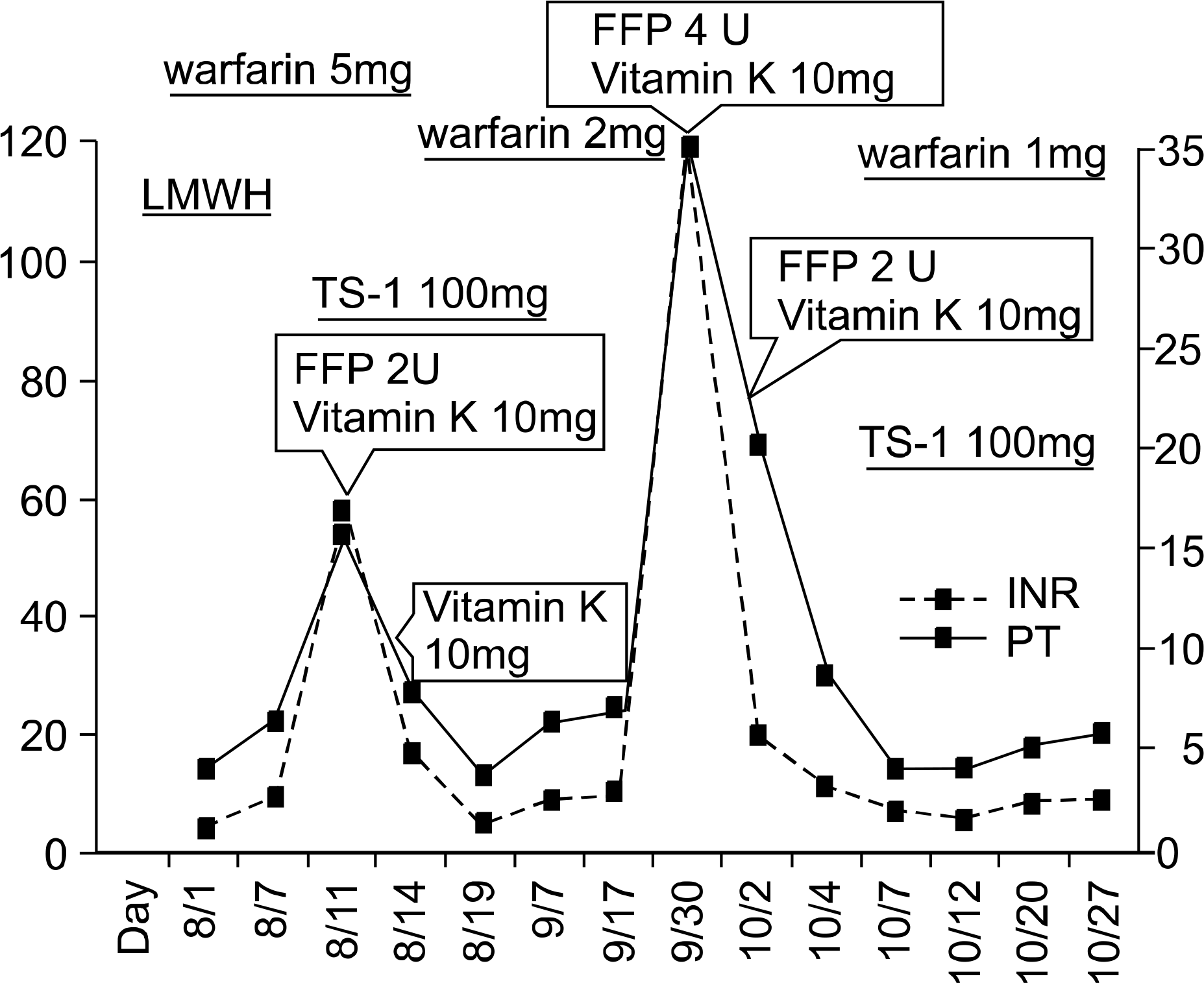Abstract
Warfarin is one of the most commonly used oral anticoagulant. It is well established that a wide range of drugs, including the anticancer drug 5-fluorouracil, interact with warfarin; this results in altered coagulation parameters and bleeding sequelae. To date, any drug interaction between warfarin and TS-1 has not been reported on. A 58-yr old woman visited emergency department with gross hematuria and soft tissue swelling involving her left thigh and buttock. She had been diagnosed as having advanced colon cancer (Duke's classification D); she had undergone right hemicolectomy and partial hepatectomy, and she had received 5-FU/leucovorin chemotherapy two years prior to admission. Recurrent disease was revealed in the liver and lungs, and so 6 cycles of FOLFIRI (5-FU, leucovorin and irinotecan) chemotherapy were given. Follow-up abdominal CT scan showed progressive disease and then TS-1 oral chemotherapy was started. She took warfarin 2mg per day because of partial thrombosis in the lower inferior vena cava and left ovarian vein. The initial laboratory tests revealed a prothrombin time of 120 seconds and an international normalized ratio of 35. Fresh frozen plasma and a parenteral vitamin K injection were given. After resorption of the subcutaneous hematoma, warfarin was restarted at a dose of 1mg per day. This case shows the significant increased bleeding tendency following the combined administration of warfarin and TS-1. Because of the potential severity of this interaction, close monitoring of the coagulation parameters is recommended for patients receiving warfarin together with TS-1.
Go to : 
REFERENCES
1). Deitcher SR. Antiplatelet, anticoagulant, and fibrinolytic therapy. Kasper DL, Braunwald E, Fauci AS, editors. Harrison's principles of internal medicine. 16th ed.New York: McGrqw Hill Co;2006. p. 687–693.
2). Shirasaka T, Tsukuda M, Inuyama Y, Taguchi T. New oral anticancer drug, TS-1 (S-1) from bench to clinic Gan To Kagaku Ryoho. 2001; 28:855–64.
3). Sulkes A. From 5 fluorouracil to the new oral fluoropyrimidines: a brief overview of four decades of clinical investigations. Isr Med Assoc J. 2001; 3:278–81.
4). van Groeningen CJ, Peters GJ, Schornagel JH, et al. Phase I clinical and pharmacokinetic study of oral S-1 in patients with advanced solid tumors. J Clin Oncol. 2000; 18:2772–9.

5). Saif MW. An adverse interaction between warfarin and fluoropyrimidines revisited. Clin Colorectal Cancer. 2005; 5:175–80.

6). Copur MS, Ledakis P, Bolton M, et al. An adverse interaction between warfarin and capecitabine: a case report and review of the literature. Clin Colorectal Cancer. 2001; 1:182–4.

7). Brown MC. An adverse interaction between warfarin and 5-fluorouracil: a case report and review of the literature. Chemotherapy. 1999; 45:392–5.

8). Scarfe MA, Israel MK. Possible drug interaction between warfarin and combinatnation of levamisole and fluorouracil. Ann Pharmacother. 1994; 28:464–7.
9). Brown MC. Multisite mucous membrane bleeding due to a possible interaction between warfarin and 5-fluorouracil. Pharmacotherapy. 1997; 17:631–3.
10). Wajima T, Mukhopadhyay P. Possible interactions between warfarin and 5-fluorouracil. Am J Hematol. 1992; 40:238.

11). Kolesar JM, Johnson CL, Freeberg BL, Berlin JD, Schiller JH. Warfarin-5-FU interaction- a consecutive case series. Pharmacotherapy. 1999; 19:1445–9.
Go to : 




 PDF
PDF ePub
ePub Citation
Citation Print
Print



 XML Download
XML Download